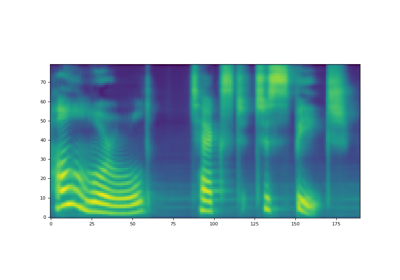Tacotron2¶
- class torchaudio.models.Tacotron2(mask_padding: bool = False, n_mels: int = 80, n_symbol: int = 148, n_frames_per_step: int = 1, symbol_embedding_dim: int = 512, encoder_embedding_dim: int = 512, encoder_n_convolution: int = 3, encoder_kernel_size: int = 5, decoder_rnn_dim: int = 1024, decoder_max_step: int = 2000, decoder_dropout: float = 0.1, decoder_early_stopping: bool = True, attention_rnn_dim: int = 1024, attention_hidden_dim: int = 128, attention_location_n_filter: int = 32, attention_location_kernel_size: int = 31, attention_dropout: float = 0.1, prenet_dim: int = 256, postnet_n_convolution: int = 5, postnet_kernel_size: int = 5, postnet_embedding_dim: int = 512, gate_threshold: float = 0.5)[source]¶
Tacotron2 模型,源自 Natural TTS Synthesis by Conditioning WaveNet on Mel Spectrogram Predictions [Shen 等人, 2018],基於 Nvidia Deep Learning Examples 的實現。
另請參閱
torchaudio.pipelines.Tacotron2TTSBundle: 帶有預訓練模型的 TTS 流水線。
- 引數:
mask_padding (bool, 可選) – 使用掩碼填充 (預設值:
False)。n_mels (int, 可選) – Mel Bin 的數量 (預設值:
80)。n_symbol (int, 可選) – 輸入文字的符號數量 (預設值:
148)。n_frames_per_step (int, 可選) – 每步處理的幀數,僅支援 1 (預設值:
1)。symbol_embedding_dim (int, 可選) – 輸入嵌入維度 (預設值:
512)。encoder_n_convolution (int, 可選) – 編碼器卷積層數量 (預設值:
3)。encoder_kernel_size (int, 可選) – 編碼器核大小 (預設值:
5)。encoder_embedding_dim (int, 可選) – 編碼器嵌入維度 (預設值:
512)。decoder_rnn_dim (int, 可選) – 解碼器 LSTM 的單元數量 (預設值:
1024)。decoder_max_step (int, 可選) – 輸出 Mel 譜圖的最大數量 (預設值:
2000)。decoder_dropout (float, 可選) – 解碼器 LSTM 的 Dropout 機率 (預設值:
0.1)。decoder_early_stopping (bool, 可選) – 在所有樣本完成後繼續解碼 (預設值:
True)。attention_rnn_dim (int, 可選) – 注意力 LSTM 的單元數量 (預設值:
1024)。attention_hidden_dim (int, 可選) – 注意力隱藏表示的維度 (預設值:
128)。attention_location_n_filter (int, 可選) – 注意力模型的濾波器數量 (預設值:
32)。attention_location_kernel_size (int, 可選) – 注意力模型的核大小 (預設值:
31)。attention_dropout (float, 可選) – 注意力 LSTM 的 Dropout 機率 (預設值:
0.1)。prenet_dim (int, 可選) – Prenet 層中的 ReLU 單元數量 (預設值:
256)。postnet_n_convolution (int, 可選) – Postnet 卷積層數量 (預設值:
5)。postnet_kernel_size (int, 可選) – Postnet 核大小 (預設值:
5)。postnet_embedding_dim (int, 可選) – Postnet 嵌入維度 (預設值:
512)。gate_threshold (float, 可選) – 停止標記的機率閾值 (預設值:
0.5)。
- 使用
Tacotron2的教程
方法¶
forward¶
- Tacotron2.forward(tokens: Tensor, token_lengths: Tensor, mel_specgram: Tensor, mel_specgram_lengths: Tuple[Tensor]) Tuple[Tensor, Tensor, Tensor, Tensor][source]¶
將輸入透過 Tacotron2 模型。這處於教師強制模式,通常用於訓練。
輸入
tokens應使用零填充至token_lengths的最大長度。輸入mel_specgram應使用零填充至mel_specgram_lengths的最大長度。- 引數:
tokens (Tensor) – Tacotron2 的輸入標記,形狀為 (n_batch, max of token_lengths)。
token_lengths (Tensor) –
tokens中每個樣本的有效長度,形狀為 (n_batch, )。mel_specgram (Tensor) – 目標 Mel 譜圖,形狀為 (n_batch, n_mels, max of mel_specgram_lengths)。
mel_specgram_lengths (Tensor) – 每個 Mel 譜圖的長度,形狀為 (n_batch, )。
- 返回:
- Tensor
Postnet 之前的 Mel 譜圖,形狀為 (n_batch, n_mels, max of mel_specgram_lengths)。
- Tensor
Postnet 之後的 Mel 譜圖,形狀為 (n_batch, n_mels, max of mel_specgram_lengths)。
- Tensor
每個時間步的停止標記輸出,形狀為 (n_batch, max of mel_specgram_lengths)。
- Tensor
來自解碼器的注意力權重序列,形狀為 (n_batch, max of mel_specgram_lengths, max of token_lengths)。
- 返回型別:
[Tensor, Tensor, Tensor, Tensor]
infer¶
- Tacotron2.infer(tokens: Tensor, lengths: Optional[Tensor] = None) Tuple[Tensor, Tensor, Tensor][source]¶
使用 Tacotron2 進行推理。輸入是一批編碼後的句子 (
tokens) 及其對應的長度 (lengths)。輸出是生成的 Mel 譜圖、其對應的長度以及來自解碼器的注意力權重。輸入
tokens應使用零填充至lengths的最大長度。- 引數:
tokens (Tensor) – Tacotron2 的輸入標記,形狀為 (n_batch, max of lengths)。
lengths (Tensor 或 None, 可選) –
tokens中每個樣本的有效長度,形狀為 (n_batch, )。如果為None,則假定所有標記都有效。預設值:None
- 返回:
- Tensor
預測的 Mel 譜圖,形狀為 (n_batch, n_mels, max of mel_specgram_lengths)。
- Tensor
預測的 Mel 譜圖的長度,形狀為 (n_batch, )。
- Tensor
來自解碼器的注意力權重序列,形狀為 (n_batch, max of mel_specgram_lengths, max of lengths)。
- 返回型別:
(Tensor, Tensor, Tensor)

